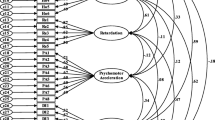Abstract
Two multidimensional mood-state inventories, the Profile of Mood States (POMS) and the Eight State Questionnaire (8SQ), were administered to 289 Australian college undergraduates. Intercorrelations for the combined 14 subscales were subjected to a higher-order factor analysis in order to elucidate the central clinical states within the mood-state sphere. Results suggested four major state dimensions pertaining to Neuroticism, Hostility/Anger, Vigor, and a combined Extroversion/Arousal-Fatigue entity. Both three- and five-factor solutions were taken out for comparative purposes. Furthermore, separate higher-order factorings of the POMS on normative samples of 350 male and 650 female psychiatric outpatients were conducted, corroborating three of the four central state dimensions, at least in the case of females. The implications of these findings for behavioral assessment are discussed.
Similar content being viewed by others
References
Barton, K., & Flocchini, S. (1985). P-technique factor analysis and the construct validity of emotional state scales.Multivariate Experimental Clinical Research, 7, 61–67.
Boyle, G. J. (1983a). Effects on academic learning of manipulating emotional states and motivational dynamics.British Journal of Educational Psychology, 53, 347–357.
Boyle, G. J. (1983b). Higher-order factor structure of Cattell's MAT and 8SQ.Multivariate Experimental Clinical Research, 6, 119–127.
Boyle, G. J. (1984). Effects of viewing a road trauma film on emotional and motivational factors.Accident Analysis and Prevention, 16, 383–386.
Boyle, G. J. (1985a). A reanalysis of the higher-order factor structure of the Motivation Analysis Test and the Eight State Questionnaire.Personality and Individual Differences, 6, 367–374.
Boyle, G. J. (1985b). Self-report measures of depression: Some psychometric considerations.British Journal of Clinical Psychology, 24, 45–59.
Boyle, G. J. (1986a). Analysis of typological factors across the Eight State Questionnaire and the Differential Emotions Scale.Psychological Reports, 59, 503–510.
Boyle, G. J. (1986b). Intermodality superfactors in the Sixteen Personality Factor Questionnaire, Eight State Battery and Objective Motivation Analysis Test.Personality and Individual Differences, 7, 583–586.
Boyle, G. J. (1987a). A conjoint dR-factoring of the 8SQ/DES-IV multivariate mood-state scales.Australian Journal of Psychology, 39, 79–87.
Boyle, G. J. (1988). Elucidation of motivation structure by dynamic calculus. In J. R. Nesselroade & R. B. Cattell (Eds.),Handbook of multivariate experimental psychology (rev. 2nd ed.). New York: Plenum.
Boyle, G. J. (1987b). Typological mood-state factors measured in the Eight State Questionnaire.Personality and Individual Differences, 8, 137–140.
Boyle, G. J., & Cattell, R. B. (1984). Proof of situational sensitivity of mood states and dynamic traits-ergs and sentiments-to disturbing stimuli.Personality and Individual Differences, 5, 541–548.
Boyle, G. J., Stanley, G. V., & Start, K. B. (1985). Canonical/redundancy analyses of the Sixteen Personality Factor Questionnaire, the Motivation Analysis Test, and the Eight State Questionnaire.Multivariate Experimental Clinical Research, 7, 113–132.
Cattell, R. B. (1978).The scientific use of factor analysis in behavioral and life sciences. New York: Plenum.
Cattell, R. B. (1979).Personality and learning theory. Vol. 1. The structure of personality in its environment. New York: Spinger.
Cattell, R. B. (1983).Structured personality-learning theory: A wholistic multivariate research approach. New York: Praeger.
Cattell, R. B., & Vogelmann, S. (1977). A comprehensive trial for the scree and KG criteria for determining the number of factors.Multivariate Behavioral Research, 12, 289–325.
Curran, J. P., & Cattell, R. B. (1976).Manual for the Eight State Questionnaire. Champaign, IL: Institute for Personality and Ability Testing.
Eichman, W. J. (1978). Review of the Profile of Mood States. In O. K. Buros (Ed.),The eighth mental measurements yearbook. Highland Park, NJ: Gryphon.
Eysenck, H. J. (1983). Personality as a fundamental concept in scientific psychology.Australian Journal of Psychology, 35, 289–304.
Gorsuch, R. L. (1983).Factor analysis (2nd ed.). Hillsdale, NJ: Erlbaum.
Hall, S. M., Rugg, D., Tunstall, C., & Jones, R. T. (1984). Preventing relapse to cigarette smoking in behavioral skill training.Journal of Consulting and Clinical Psychology, 52, 372–382.
Itil, T. M., Michael, S. T., Baccari, S., Blasucci, D., Shapiro, D., & Guthrie, M. (1984). Antidepressant effects of fluotracen, a long-acting potent thymoleptic (a double-blind controlled trial).Current Therapeutic Research, 35, 1014–1032.
Jacobson, A. F., Weiss, B. L., Steinbook, R. M., Brauzer, B., & Goldstein, B. J. (1978). The measurement of psychological states by use of factors derived form a combination of items from mood and symptom checklists.Journal of Clinical Psychology, 34, 677–685.
Kleinmuntz, B. (1978). Review of the Eight State Questionnaire. In O. K. Buros (Ed.),The eighth mental measurements yearbook. Highland Park, NJ: Gryphon.
Kline, P. (1979).Psychometrics and psychology. London: Academic.
Malouff, J. M., Schutte, N. S., & Ramerth, W. (1985). Evaluation of a short form of the POMS-Depression scale.Journal of Clinical Psychology, 41, 389–391.
McNair, D. M., Lorr, M., & Droppleman, L. F. (1981).EITS manual for the Profile of Mood States. San Diego: Educational & Industrial Testing Service.
Myhill, J., & Lorr, M. (1985). Comparisons of psychiatric outpatients with controls on bipolar Profile of Mood States.Psychological Reports, 56, 779–782.
Norcross, J. C., Guadagnoli, E., & Prochaska, J. O. (1984). Factor structure of the Profile of Mood States (POMS): Two partial replications.Journal of Clinical Psychology, 40, 1270–1277.
Reddon, J. R., Marceau, R., & Holden, R. R. (1985). A confirmatory evaluation of the Profile of Mood States: Convergent and discriminant item validity.Journal of Psychopathology and Behavioral Assessment, 7, 243–259.
Spielberger, C. D. (1972). Review of the Profile of Mood States.Professional Psychology, 3, 387–388.
Weckowicz, T. E. (1978). Review of the Profile of Mood States. In O. K. Buros (Ed.),The eighth mental measurements yearbook. Highland Park, NJ: Gryphon.
Author information
Authors and Affiliations
Additional information
This study was supported by a Research Development Grant awarded to the author by the University of Melbourne.
Rights and permissions
About this article
Cite this article
Boyle, G.J. Central clinical states: An examination of the Profile of Mood States and the Eight State Questionnaire. J Psychopathol Behav Assess 10, 205–215 (1988). https://doi.org/10.1007/BF00962545
Accepted:
Issue Date:
DOI: https://doi.org/10.1007/BF00962545




